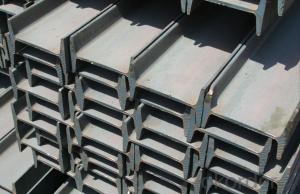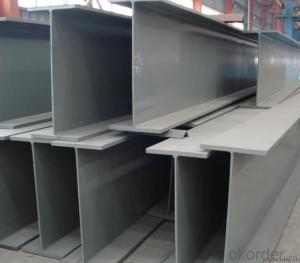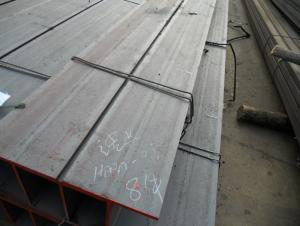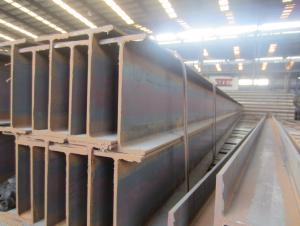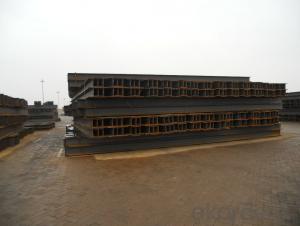High Quality Low Carbon H Beams for Structure
- Loading Port:
- China Main Port
- Payment Terms:
- TT or LC
- Min Order Qty:
- 100 m.t.
- Supply Capability:
- 10000 m.t./month
OKorder Service Pledge
OKorder Financial Service
You Might Also Like
Product Description:
OKorder is offering High Quality Low Carbon H Beams for Structure at great prices with worldwide shipping. Our supplier is a world-class manufacturer of steel, with our products utilized the world over. OKorder annually supplies products to African, South American and Asian markets. We provide quotations within 24 hours of receiving an inquiry and guarantee competitive prices.
Product Applications:
High Quality Low Carbon H Beams for Structure are ideal for structural applications and are widely used in the plant, high-rise building construction; the bridge, shipment building; lifting and transportation machinery, equipment manufacturing base building; the support, foundation pile manufacturing
Product Advantages:
OKorder's High Quality Low Carbon H Beams for Structure are durable, strong, and wide variety of sizes.
Main Product Features:
· Premium quality
· Prompt delivery & seaworthy packing (30 days after receiving deposit)
· Can be recycled and reused
· Mill test certification
· Professional Service
· Competitive pricing
Product Specifications:
Manufacture: Hot rolled
Grade: Q195 – 235
Certificates: ISO, SGS, BV, CIQ
Length: 12m, as per customer request
Packaging: Export packing, nude packing, bundled
| H BEAM | ||||||
| size | h (MM) | b (MM) | t1 (MM) | t2 (MM) | Mass: Kg/m | LENGTH |
| 100x100 | 100 | 100 | 6.0 | 8 | 16.9 | 12M |
| 125x125 | 125 | 125 | 6.5 | 9 | 23.6 | 12M |
| 150x75 | 150 | 75 | 5.0 | 7 | 14.0 | 12M |
| 148x100 | 148 | 100 | 6.0 | 9 | 20.7 | 12M |
| 150x150 | 150 | 150 | 7.0 | 10 | 31.1 | 12M |
| 175x90 | 175 | 90 | 5.0 | 8 | 18.0 | 12M |
| 175x175 | 175 | 175 | 5.0 | 11 | 40.4 | 12M |
| 198x99 | 198 | 99 | 4.5 | 7 | 17.8 | 12M |
| 200x100 | 200 | 100 | 5.5 | 8 | 20.9 | 12M |
| 194x150 | 194 | 150 | 6.0 | 9 | 29.9 | 12M |
| 200x200 | 200 | 200 | 8.0 | 12 | 49.9 | 12M |
| 200x204 | 200 | 204 | 12.0 | 12 | 56.2 | 12M |
| 248x124 | 248 | 124 | 5.0 | 8 | 25.1 | 12M |
| 250x125 | 250 | 125 | 6.0 | 9 | 29.0 | 12M |
| 244x175 | 244 | 175 | 7.0 | 11 | 43.6 | 12M |
| 250x250 | 250 | 250 | 9.0 | 14 | 71.8 | 12M |
| 250x255 | 250 | 255 | 14.0 | 14 | 81.6 | 12M |
| 298x149 | 298 | 149 | 5.5 | 8 | 32.0 | 12M |
| 300x150 | 300 | 150 | 6.5 | 9 | 36.7 | 12M |
| 294x200 | 294 | 200 | 8.0 | 12 | 55.8 | 12M |
| 294x302 | 294 | 302 | 12.0 | 12 | 83.4 | 12M |
| 300x300 | 300 | 300 | 10.0 | 15 | 93.0 | 12M |
| 300x305 | 300 | 305 | 15.0 | 15 | 105.0 | 12M |
| 346x174 | 346 | 174 | 6.0 | 9 | 41.2 | 12M |
| 350x175 | 350 | 175 | 7.0 | 11 | 49.4 | 12M |
| 340x250 | 340 | 250 | 9.0 | 14 | 78.1 | 12M |
| 344x348 | 344 | 348 | 10.0 | 16 | 113.0 | 12M |
| 350x350 | 350 | 350 | 12.0 | 19 | 135.0 | 12M |
| 396x199 | 396 | 199 | 7.0 | 11 | 56.1 | 12M |
| 400x200 | 400 | 200 | 8.0 | 13 | 65.4 | 12M |
| 400x300 | 400 | 300 | 10.0 | 16 | 105 | 12M |
| 388x402 | 388 | 402 | 15.0 | 15 | 140 | 12M |
| 394x398 | 394 | 398 | 11.0 | 18 | 147 | 12M |
| 400x400 | 400 | 400 | 13.0 | 21 | 172 | 12M |
| 400x408 | 400 | 408 | 21.0 | 21 | 197 | 12M |
| 414x405 | 414 | 405 | 18 | 28 | 232 | 12M |
| 428x407 | 428 | 407 | 20 | 35 | 283 | 12M |
| 458x417 | 458 | 417 | 30 | 50 | 415 | 12M |
| 498x432 | 498 | 432 | 45 | 70 | 605 | 12M |
| 446x199 | 446 | 199 | 8 | 12 | 65.1 | 12M |
| 450x200 | 450 | 200 | 9 | 14 | 74.9 | 12M |
| 440x300 | 440 | 300 | 11 | 18 | 121 | 12M |
| 496x199 | 496 | 199 | 9 | 14 | 77.9 | 12M |
| 500x200 | 500 | 200 | 10 | 16 | 88.2 | 12M |
| 506x201 | 506 | 201 | 11 | 19 | 102 | 12M |
| 482x300 | 482 | 300 | 11 | 15 | 111 | 12M |
| 488x300 | 488 | 300 | 11 | 18 | 125 | 12M |
| 596x199 | 596 | 199 | 10 | 15 | 92.5 | 12M |
| 600x200 | 600 | 200 | 11 | 17 | 103 | 12M |
| 606x201 | 606 | 201 | 12 | 20 | 118 | 12M |
| 582x300 | 582 | 300 | 12 | 17 | 133 | 12M |
| 588x300 | 588 | 300 | 12 | 20 | 147 | 12M |
| 594x302 | 594 | 302 | 14 | 23 | 170 | 12M |
| 692x300 | 692 | 300 | 13 | 20 | 163 | 12M |
| 700x300 | 700 | 300 | 13 | 24 | 182 | 12M |
| 792x300 | 792 | 300 | 14 | 22 | 188 | 12M |
| 800x300 | 800 | 300 | 14 | 26 | 207 | 12M |
| 890x299 | 890 | 299 | 15 | 23 | 210 | 12M |
| 900x300 | 900 | 300 | 16 | 28 | 240 | 12M |
| 912x302 | 912 | 302 | 18 | 34 | 283 | 12M |
FAQ:
Q1: Why buy Materials & Equipment from OKorder.com?
A1: All products offered byOKorder.com are carefully selected from China's most reliable manufacturing enterprises. Through its ISO certifications, OKorder.com adheres to the highest standards and a commitment to supply chain safety and customer satisfaction.
Q2: How many tons of steel products could be loaded in containers?
A2: Usually the steel products are delivered by bulk vessel because of the large quantity and the freight. However, there are no bulk vessel enter some seaports so that we have to deliver the cargo by containers. The 6m steel product can be loaded in 20FT container, but the quantity is changed according to the size, usually from 18tons to 25tons.
Q3: How soon can we receive the product after purchase?
A3: Within three days of placing an order, we will arrange production. The normal sizes with the normal grade can be produced within one month. The specific shipping date is dependent upon international and government factors, the delivery to international main port about 45-60days.
Images:
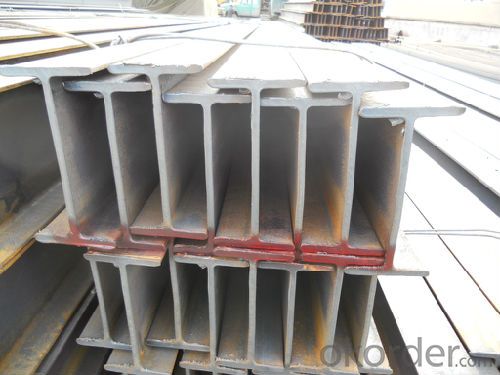
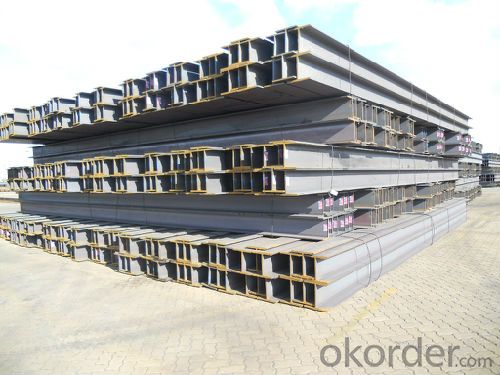
- Q:Are steel H-beams resistant to mold and mildew?
- Mold and mildew growth is not a common problem with Steel H-beams. Mold and mildew need organic materials, like wood or fabric, to thrive, which are often found in building materials such as drywall or insulation. Unlike these materials, steel is inorganic and does not provide a suitable environment for mold and mildew to grow. Moreover, steel H-beams are frequently used in structural applications where moisture is effectively managed and controlled, minimizing the chances of mold and mildew growth. It is worth noting, however, that if steel H-beams are exposed to excessive moisture or placed in high humidity areas, condensation may form on their surfaces. Although this won't directly cause mold and mildew growth on the steel itself, it could create a damp atmosphere that indirectly promotes the growth of mold and mildew on nearby materials. Therefore, it is crucial to implement proper measures for moisture control and ventilation in order to prevent any potential issues.
- Q:What are the factors that affect the cost of steel H-beams?
- There are several factors that can affect the cost of steel H-beams: 1. Raw material costs: The cost of the raw materials used to manufacture steel H-beams, such as iron ore and coal, can have a significant impact on the overall cost. Fluctuations in the prices of these materials, influenced by factors like supply and demand, can directly affect the cost of producing steel H-beams. 2. Manufacturing process: The method used to manufacture steel H-beams can also impact their cost. Different manufacturing processes, such as hot-rolling or cold-forming, require varying levels of energy, labor, and equipment, which can affect the overall cost. 3. Size and weight: The size and weight of the steel H-beams can impact the cost. Larger and heavier beams require more raw material and may require additional handling and transportation costs, which can increase the overall price. 4. Market demand: The demand for steel H-beams can also affect their cost. If there is a high demand for these beams, prices may increase due to limited supply. Conversely, if the demand is low, prices may be lower as manufacturers compete for customers. 5. Trade policies and international market conditions: Trade policies and international market conditions can also impact the cost of steel H-beams. Factors such as tariffs, import restrictions, and currency exchange rates can affect the cost of raw materials and the overall cost of production, which in turn can impact the final price of the beams. 6. Manufacturing location: The geographical location of the manufacturing facility can also play a role in the cost of steel H-beams. Different regions may have varying labor costs, energy costs, and transportation costs, all of which can affect the final price of the beams. 7. Quality and specifications: The quality and specifications of the steel H-beams can also influence their cost. Higher quality beams that meet stricter standards and specifications may command a higher price compared to lower quality beams. Overall, the cost of steel H-beams is influenced by various factors, including raw material costs, manufacturing process, size and weight, market demand, trade policies, manufacturing location, and quality and specifications. Understanding these factors can help buyers and sellers make informed decisions and negotiate prices effectively.
- Q:Are steel H-beams suitable for structures with architectural features?
- Yes, steel H-beams are suitable for structures with architectural features. Steel H-beams are widely used in construction due to their strength, versatility, and ability to support various architectural designs. They can be fabricated and shaped to create unique architectural features while providing structural support. Their durability and load-bearing capacity make them an ideal choice for creating aesthetically pleasing structures with intricate architectural details.
- Q:How do steel H-beams compare to timber or concrete beams?
- Steel H-beams have several advantages over timber or concrete beams. Firstly, steel H-beams are much stronger and more durable than timber or concrete beams. Steel has a higher strength-to-weight ratio, meaning that it can support heavier loads while being lighter in weight. This allows for longer spans and larger open spaces in construction. In contrast, timber beams are prone to warping, rotting, or insect damage, while concrete beams may crack or deteriorate over time. Secondly, steel H-beams are more resistant to fire and other extreme conditions. Steel has a high melting point and does not burn, making it a safer choice in case of fire accidents. Timber beams, on the other hand, are highly flammable and can contribute to the rapid spread of fire. Concrete beams may also crack and fail under extreme heat or cold conditions. Furthermore, steel H-beams offer better flexibility and versatility in design. They can be easily fabricated into various shapes, sizes, and lengths to meet specific project requirements. Steel beams also have consistent dimensions, allowing for easier and faster installation. In contrast, timber beams are limited in terms of available sizes and may require additional processing. Concrete beams are typically cast on-site, which can be time-consuming and labor-intensive. Lastly, steel H-beams have a longer lifespan and require less maintenance compared to timber or concrete beams. Steel is resistant to corrosion, rot, and decay, making it a more durable and cost-effective choice in the long run. Timber beams need regular inspections, treatments, and replacements to maintain their structural integrity. Concrete beams may develop cracks or require repairs over time. In summary, steel H-beams offer superior strength, durability, fire resistance, design versatility, and low maintenance compared to timber or concrete beams. These advantages make steel H-beams a preferred choice in many construction projects, especially those with higher load-bearing requirements or in locations prone to extreme conditions.
- Q:What are the common sizes of steel H-beams used in residential construction?
- The common sizes of steel H-beams used in residential construction vary depending on the specific requirements of the project. However, there are a few standard sizes that are commonly used in residential construction. One of the most common sizes is the 6-inch by 6-inch H-beam, which is often used as a load-bearing member in residential structures. This size provides sufficient strength and support for many typical residential applications. Another commonly used size is the 8-inch by 8-inch H-beam. This larger size is often used in situations where greater strength and load-bearing capacity are required, such as in the construction of larger homes or buildings with multiple stories. In addition to these standard sizes, there are also various other sizes available depending on the specific needs of the project. These can range from smaller beams for lighter loads to larger beams for heavier loads. It's important to note that the specific sizes and specifications of steel H-beams used in residential construction may vary depending on local building codes, structural engineering requirements, and the type of construction being undertaken. Consulting with a structural engineer or construction professional is crucial to ensure that the appropriate size of H-beam is selected for a specific residential construction project.
- Q:Can steel H-beams be used for water treatment plants?
- Yes, steel H-beams can be used for water treatment plants. Steel H-beams are a versatile and commonly used structural component in various construction projects, including water treatment plants. They provide excellent strength and durability, making them suitable for supporting heavy loads and withstanding harsh environmental conditions. In water treatment plants, steel H-beams can be used for constructing the framework of the facility, supporting equipment and machinery, and creating walkways and platforms. Additionally, steel H-beams can be easily fabricated and customized to meet specific design requirements, ensuring a precise fit and optimal functionality in water treatment plant construction.
- Q:What are the characteristics of steel H-beams that make them suitable for industrial applications?
- Steel H-beams have several characteristics that make them ideal for industrial applications. Firstly, they have a high strength-to-weight ratio, which enables them to bear heavy loads while minimizing their own weight. This makes them suitable for constructing large structures such as bridges, buildings, and industrial facilities. Additionally, their durability and resistance to deformation and bending ensure structural stability and longevity. Moreover, the H shape provides enhanced support and stability, allowing for efficient distribution of weight and reducing the need for additional support structures. These characteristics make steel H-beams a reliable and cost-effective choice for various industrial applications.
- Q:What are the considerations when designing for natural disaster planning in Steel H-Beams?
- There are several important factors to consider when designing Steel H-Beams for natural disaster planning. Firstly, it is crucial to ensure that the H-Beams have sufficient load-bearing capacity to withstand the forces exerted during a natural disaster. This involves calculating the maximum expected loads and stresses that the beams may experience and designing them to safely handle these forces. The choice of materials for the H-Beams is also crucial in natural disaster planning. Steel is often preferred due to its high strength and durability. The steel used should possess appropriate mechanical properties, such as high tensile strength and ductility, to withstand the dynamic forces associated with natural disasters. Compliance with relevant design codes and standards is essential to ensure the structural integrity of the H-Beams. These codes provide guidelines on factors such as minimum safety factors, design loads, and construction practices specific to natural disaster-prone areas. Incorporating redundancy into the design is important to enhance the resilience of the structure. This can be achieved by providing additional beams or bracing elements to distribute the loads more evenly and prevent the collapse of the entire structure in case of localized failures. If the natural disaster being planned for is an earthquake, additional seismic considerations need to be taken into account. This includes designing the H-Beams to withstand the ground motion induced by earthquakes and incorporating seismic isolation or energy dissipation devices to reduce the impact of seismic forces on the structure. The connection details between the H-Beams and other structural elements are critical for overall structural stability. These connections should be designed to resist the anticipated forces and moments and maintain their integrity during a natural disaster. Considerations for ease of construction and maintenance should also be incorporated into the design. This includes ensuring that the H-Beams can be installed and maintained easily, as well as providing provisions for regular inspections and repairs to maintain their structural integrity over time. By carefully considering these factors, designers can create H-Beam structures that are resilient and capable of withstanding the forces imposed by natural disasters, thereby ensuring the safety of the occupants and minimizing damage to the overall infrastructure.
- Q:What are the considerations for selecting the appropriate size of steel H-beams?
- When choosing the right size of steel H-beams, there are several factors to consider. Firstly, the load capacity is crucial. This includes both the weight of the structure itself and any additional live loads. Accurately calculating the total load is essential to avoid overloading the H-beam. Secondly, the span length plays a significant role. Longer spans require larger and stronger H-beams for adequate support. Consulting structural engineering guidelines helps determine the maximum allowable span length for a specific H-beam size. Additionally, deflection should be taken into account. Excessive bending or flexing of the beam under load can compromise the integrity of the structure. By considering the load and span length, deflection calculations can be made to ensure the selected H-beam size provides sufficient stiffness. Cost is another important consideration. Larger and stronger H-beams tend to be more expensive. It is essential to find a balance between load requirements and the available budget to select the most cost-effective option that meets the structural needs. Availability and fabrication should also be considered. Checking with suppliers to ensure the desired H-beam size is readily available and easily obtained is crucial. If customization or specific fabrication processes are necessary, the ease and cost of these processes should also be taken into account. In conclusion, selecting the appropriate size of steel H-beams requires considering factors such as load capacity, span length, deflection, cost, availability, and fabrication. Taking all these factors into account ensures the project's structural integrity and efficiency.
- Q:What are the common methods for joining steel H-beams in construction?
- The common methods for joining steel H-beams in construction include welding, bolting, and riveting. Welding involves melting the two beams together at the joint using high heat, creating a strong and permanent bond. Bolting involves using bolts and nuts to secure the beams together, providing a strong and flexible connection. Riveting involves inserting metal rivets through pre-drilled holes in the beams and then hammering them to create a secure connection. Each method has its advantages and is chosen based on the specific requirements of the construction project.
1. Manufacturer Overview |
|
|---|---|
| Location | |
| Year Established | |
| Annual Output Value | |
| Main Markets | |
| Company Certifications | |
2. Manufacturer Certificates |
|
|---|---|
| a) Certification Name | |
| Range | |
| Reference | |
| Validity Period | |
3. Manufacturer Capability |
|
|---|---|
| a)Trade Capacity | |
| Nearest Port | |
| Export Percentage | |
| No.of Employees in Trade Department | |
| Language Spoken: | |
| b)Factory Information | |
| Factory Size: | |
| No. of Production Lines | |
| Contract Manufacturing | |
| Product Price Range | |
Send your message to us
High Quality Low Carbon H Beams for Structure
- Loading Port:
- China Main Port
- Payment Terms:
- TT or LC
- Min Order Qty:
- 100 m.t.
- Supply Capability:
- 10000 m.t./month
OKorder Service Pledge
OKorder Financial Service
Similar products
New products
Hot products
Related keywords
